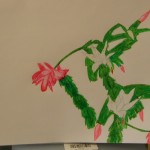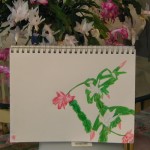FOCUSING AND CREATIVITY: FINDING TREASURE IN BLOCKS
RELEASING BLOCKS TO CREATIVITY
“Treasure Maps To The Soul”
Ann Weiser Cornell and Barbara McGavin, Certified Focusing Trainers, have made a life’s work at discovering the treasures that lie within our deepest conflicts, action blocks, addictions, depression, and other forms of “stuckness.” They have developed a workshop called “Treasure Maps To The Soul” which introduces participants to many forms of “stuckness,” like the Swamp, The Fog, The Dragon, and how to use Focusing to find the treasure, the life-direction forward, in each of these blocks.
Central to their method is “the radical acceptance of everything.” Taking a neutral position of Presence inside, the Focuser then welcomes and greets with curiosity ANY inner experience that wants to come forward, without judgment. With respectful and compassionate Listening to EVERY part, EVERY aspect, their Inner Relationship Focusing allows even the most hated “blocks” and “critics” to soften, to express their own positive wants and needs and wishes to protect the Focuser.
In experiencing a “block,” there is a “part” of us that wants to go forward, to do our creative project, and a “part” that holds us back. We plan to paint, and never get to it. We sit down to write, and become totally blank, feeling suffocated. We try to write a report, and find ourselves daydreaming. Usually, we try to “beat up” or “beat down” the “part” that we see as getting in the way, holding us back.
In Focusing, we stop this inner battle and finally turn with compassionate Listening to this blocking part, asking, “Okay, what is going on for you — ? What do you need?— What are you trying to protect us from?—How can I allow you to be welcome and present while we attempt this task?” And the Focuser also then takes time to Listening with compassionate curiosity to the “part” that DOES want to go forward, its needs, wishes, fears, hopes, etc. By going back and forth between the two, Focusing allows something to “shift” inside, and a new possibility for going forward to arise. Here is the Introduction to one of Ann’s Articles from her website for Focusing Resources:
How To Use Focusing To Release Blocks To Action
by Ann Weiser Cornell, PhD
This article originally appeared in the January 1993 issue of The Focusing Connection (Subscribe).Writer’s block, procrastination, being a pack rat… all these are action blocks. If you want to start an exercise program but you don’t, if you want to keep your desk clean but you don’t, if you want to be more creative but it just doesn’t happen, you are experiencing an action block–and Focusing can help. Action blocks are painful, and everyone experiences them at times. For some people, the struggle dominates their lives. Are you familiar with wanting to do something day after day, even cursing and criticizing yourself for not doing it? Do you know about making resolution after resolution, even changing for a little while, but always sliding back? Wouldn’t you love to be able to break that cycle and act easily and confidently instead? Focusing releases the stuck system by changing the dynamic that holds the action block in place. In an action block, there is a part of you that isn’t being heard. Ironically, that’s the same part of you that seems to be in charge: the one that isn’t taking action. It has you in its iron grip, and yet it’s lonely, isolated, unacknowledged. No one has really asked it yet, “How come you’re so set against taking action?” (Remember, being sure that you already know why is not the same thing as asking it!) The Focusing process starts by bringing in self-compassion instead of self-criticism. This alone begins the process of release, because self-criticism is the glue that holds the action block in place. It’s funny, isn’t it, that it often feels like just the opposite is true? I feel like my criticism of the part of me that won’t exercise is my only hope of moving it, and that if I accept it, it will really take over my life! But actually, self-criticism holds the system in place because it ensures that the criticized part will not be heard, and everything will stay the same. And remember: compassion and acceptance are not the same as agreement or giving in. I can still want to change, while being compassionate to the part of me that doesn’t want to. Through Focusing, we create an inner atmosphere of safety, where any part of us can be heard without being attacked or criticized. This is important, because if you want to hear the truth and be released, you can’t put pre-conditions on what you hear. “You can tell me anything except…” just won’t work. In Focusing, it is quite literally true that the truth will set you free. So if you want to set the stage for allowing truth to come, start with an inner atmosphere of compassion, if possible. (If something in you says “No” to being compassionate, see if you can be compassionate to that!)
Listening to the Part that Blocks You —“READ ON AT ANN’S WEBSITE and check out the many other great articles in her Library and Workshop Offerings.
FOCUSING EXERCISE: RELEASING BLOCKS TO CREATIVITY
Last week, we used Focusing just to work with the “intuitive feel,” the “bodily-felt sense” of next steps in a creative project. We will return to this. But, for today, I ask you to look for a place in your life where you are “stuck” or “blocked” in terms of a creative project, where you are trying to move forward but continuously are holding yourself back at the same time. To begin the Focusing Exercise below, I will ask you to scan your life and choose a “blocked project,” then lead you through Focusing instructions which allow you to “listen to” both sides in the conflict, allowing new possibilities for moving forward to emerge:
Leave at least one minute of silence between each instruction
(One minute)
Okay — first, just get yourself comfortable — feel the weight of your body on the chair — loosen any clothing that is too tight —
(One minute)
Spend a moment just noticing your breathing — don’t try to change it — just notice the breath going in — and out —
(One minute —)
Now, notice where you have tension in your body (pause) —
(One minute — )
Now, imagine the tension as a stream of water, draining out of your body through your fingertips and feet (Pause) —
(One minute — )
Let yourself travel inside of your body to a place of peace —
(One minute — )
Now, bring to mind a creative problem or project that needs attention, particularly one where there is some blockage to forward movement. Take as long as you need to scan your life, looking for something with this kind of “stuckness” (pause) —
(One minute or more — )
Choose one “blocked” project, and spend a moment just bringing it fully to mind, thinking about where you are in relation to it, where you “left off,” the “next step,” the “block” —
(One minute — )
Now, try to set aside all of your thoughts about the situation and possible solutions, and, as you carry a mental image of the problem or project in your mind, just wait and see what comes in the center of your body, around your heart/chest area, in response (pause) — not words, but the intuitive feel of the whole situation, The Creative Edge —
(One minute — )
Now, carefully try to find words or an image for that Edge — Go carefully back and forth between any words and the intuitive feel of the whole thing until you find words or an image that are just right for it —
(One minute — )
Now, gently ask yourself, “What is in the way here? What is the body-sense for the part that gets in the way, doesn’t want to work on the project”, and wait, at least a minute, to see what comes in your wordless intuition, your whole-body sense, The Creative Edge —
(One minute —)
Carefully look for some words or an image or metaphor that exactly fit that Edge —
(One minute — )
Now, ask that “resisting” or “critical” part, “What is this like for you? Why are you holding back? Is there something you are wanting to protect me from? Is there something you are wishing for?” Take some time just to “listen to” how it is for this part of yourself. Go back-and-forth between words/images and the “bodily feel” of that part until you have captured the “feel of it all” —
(One – three minutes — )
Now, turn your attention to the other side, the “part” of you that wants to move forward, to tackle the project, to have the pleasure of creating. Spend some time looking for the “intuitive feel” of this forward-moving, creating part or energy. Don’t answer from your head, what you already know, but wait, as long as a minute, for an answer to come in the center of your body, your wordless intuition, The Creative Edge —
(One minute — )
Again, carefully find words or an image for that, ” the part that wants to create” Weiser Cornell suggests that you imagine yourself working on the project, being free-flowing creative, and get the “body-feel” for what that is like, and find some words or images/metaphors to capture that–
(One to three minutes — )
And ask that part some open-ended questions, like “What is this like for you, being creative?— What are you wanting/needing?— What is a first step you can imagine for moving forward?”. Again, don’t answer from your head, but wait as much as a minute for “the feel of that whole thing” to arise, and then carefully go back-and-forth, finding words/images/metaphors/gestures to capture the “intuitive feel.”
(One to three minutes —)
Continue in this way, going back and forth between the two sides, asking each, “And how is that for you?” , waiting to see what comes in your body, finding words and images for that, letting each side fully express itself. If other “parts” arise, make room for them as well, giving them time to express themselves.
As you spend compassionate, non-judgmental Listening time with each aspect of the situation, you will find the different “sides” softening and blending, becoming more understanding of each others’ needs, more willing to look for an acceptable “next step forward.”
Weiser Cornell and McGavin suggest you pay special attention to what the “blocking, holding back” aspect is “afraid of” or “wanting to protect” the Focuser from, and what it does want for the Focuser. They find that Critical and Blocking parts are often motivated by FEAR and think they are working in the best interest of the person, guarding and protecting from fearful outcomes in the only way they know how.
Spend as long as is comfortable listening to the various aspects of your “conflicted” situation, looking for a possible step forward. If no clear next step arises, just remind yourself that, by spending Focusing time sitting with The Creative Edge, you have added energy and started a new living-forward, and, especially if you continue to hold “the feel of it all” on the back-burner of your mind, later something new will likely pop up —
(One minute)
Appreciate yourself and your “subconscious,” the “intuitive feel,” for taking time with this, trusting that taking time is the important thing — solutions can then arise later.
Remember, it is often easier to learn Intuitive Focusing with the company of a Focusing Listener. See links below to find many resources, including self-help groups, and Creative Edge Focusing Consultants for individual Coaching or Classes and Workshops.
Download complete Instant “Ahah!” Mini-Manual, in English and Spanish, from CEF Website
Find links to free articles, personality tests, multi-media Self-Help training, Classes and workshops
Dr. Kathy McGuire, Director
The site of new insights and creative solutions is at the edge of what is already known. This edge, The Creative Edge, holds implicit within it all past and future knowing about the problem, more than could ever be put into words in a linear way


